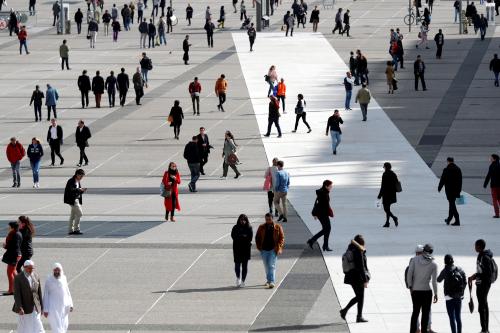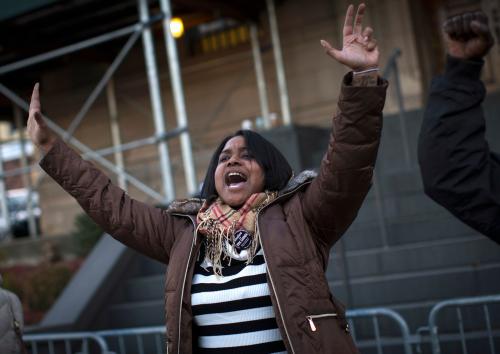The nation’s juvenile crime problem is grave and growing. Unfortunately, the debate over how to respond to violence by teen-agers is being waged along the usual ideological and partisan lines.
Last month, House Republicans proposed legislation that would end Federal mandates requiring states to segregate juveniles from adults in jails and prisons. But this proposal is a step in the wrong direction.
There is a crisis. In 1994, 2.7 million juveniles were arrested, more than a third of them under 15 years old. Juvenile offenders were responsible for 14 percent of all violent crimes and a quarter of all property crimes. Males, 14 to 24 years old, were only 8 percent of the population, but they made up more than a quarter of all homicide victims and nearly half of all murderers.
Black and Latino juveniles figure ever more disproportionately as both victims and perpetrators. James Alan Fox, a criminologist, reports that 14- to 24-year-old black males were jut 1 percent of the population in 1992, but that they made up 17 percent of homicide victims and 30 percent of the offenders.
In 1980, juveniles were murdered at a rate of five per day. By 1994, the rate was seven per day, and most of the juveniles were 15 to 17 years old.
Violence committed by teen-agers will probably only get worse. Over the next 15 years, the number of juveniles under 17 will grow to about 74 million. Most experts now agree that the number of juveniles arrested for murder, rape, robbery and aggravated assault will more than double by 2010.
As James Q. Wilson, a professor of public policy at U.C.L.A., has written, Americans rightly believe that “something fundamental has changed in our patterns of crime,” namely the threat of serious crimes committed by “youngsters who afterwards show us the blank, unremorseful stare of a feral, presocial being.”
Some have denied this “superpredator” reality by noting that “only” one-half of 1 percent of all juveniles are arrested for a violent crime each year. But that translates into more than 150,000 juveniles arrested for violent crimes, including utterly senseless drive-by shooting, gang assaults and “joy killings.”
Legitimate public concerns justify imprisoning repeat offenders of whatever age. But housing juvenile criminals with adult felons will not help decrease the rate of violent crime.
Most juvenile offenders are not guilty of repeated or random acts of serious violence. Most kids who get into serious trouble with the law need adult guidance. And they won’t find suitable role models in prison. Jailing youths with adult felons under Spartan conditions will merely produce more street gladiators.
In the 1970’s, liberals made the mistake of releasing juvenile offenders from jail without considering the violence that more hardened youth would unleash, and without developing any real community network to meet the basic emotional, medical and educational needs of criminally wayward but socially redeemable youth.
Today, we need not choose between putting juvenile offenders in adult jails and indiscriminately releasing criminals to the streets. We can and should choose real reform.
That means enacting more effective gun-control and drug-abuse laws and sentencing violent teen-agers to long prison terms. But even then we would still have millions of children whose spiritual and material conditions demand our attention.
We must acknowledge that most teen-age predators begin as severely at-risk children. As Mark Fleisher, an urban ethnographer, has observed, an “abundance of scholarly evidence shows that antisocial and delinquent tendencies emerge early in the lives of neglected, abused and unloved youngsters, often by age 9.”
Cut to its core, the evidence shows that children are less likely to commit violent crime if they have responsible adults in their lives. Even impoverished kids living in crime-ravaged neighborhoods tend to make it if they have an adult parent, teacher, coach or clergy to protect and guide them.
Juveniles who commit the worst crimes have almost always been raised without adult care and supervision. Indeed, they usually have suffered a lifetime of abuse and neglect.
A study by the National Institute of Justice found that a child who suffers from abuse and neglect is 40 percent more likely to become delinquent. Numerous studies find that most juvenile felons come from families plagued by violence, chaos and high rates of drug and alcohol abuse.
Indeed, about half of the youngsters in juvenile jails have at least one immediate family member who was incarcerated, and juveniles who commit violent crimes have typically witnessed or experienced serious violence themselves at an early stage.
Evidence shows that even these children can be saved. For example, Public/Private Ventures, which studies and develops programs for youth ( and of which I am a board member), has identified a number of winning projects. One of its recent studies showed that at-risk, low-income children who met with a Big Brother or Big Sister three times a month for four hours each time were 46 percent less likely than their peers to start using illegal drugs and a third less likely to assault someone.
Faith-based programs are especially good at insulating children from the temptations of drugs and crime. A leading example is what the Rev. Eugene Rivers of the Azusa Church in Boston and other black clergy have done to create a successful network of 39 churches that serves troubled and drug-addicted youth, performs neighborhood patrols and counsels juveniles on probation.
Let us do all we can to protect ourselves from teen-age predators. But let us also do all we should to rescue children who are at risk.



Commentary
Op-edStop Crime Where it Starts
July 31, 1996